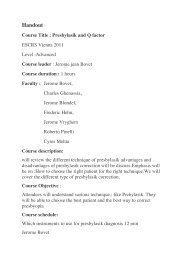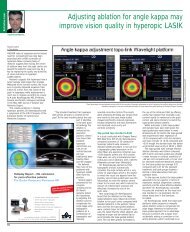ESCRS Guidelines on prevention, investigation and management of
ESCRS Guidelines on prevention, investigation and management of
ESCRS Guidelines on prevention, investigation and management of
You also want an ePaper? Increase the reach of your titles
YUMPU automatically turns print PDFs into web optimized ePapers that Google loves.
In the <str<strong>on</strong>g>ESCRS</str<strong>on</strong>g> Study, 29 patients presented with presumed post-operative endophthalmitis, <strong>of</strong> whom 20 were<br />
classified as having proven infective endophthalmitis. The causative bacteria were identified by<br />
microbiological methods <strong>and</strong> polymerase chain reacti<strong>on</strong> (PCR) [11]. From 19 cases the following bacteria<br />
have been c<strong>on</strong>firmed:<br />
Staphylococcus epidermidis 6<br />
CNS 4<br />
Staphylococcus aureus 2<br />
other staphylococci 1<br />
Streptococcus pneum<strong>on</strong>iae 2<br />
other streptococci 6<br />
Propi<strong>on</strong>ibacterium acnes 1<br />
Gemella haemolysans 1<br />
In summary, the most important pathogens causing post-operative phacoemulsificati<strong>on</strong> endophthalmitis are:<br />
Acute<br />
■ BHS, S. mitis, S. pneum<strong>on</strong>iae, E. faecalis<br />
■ S. aureus, CNS, (MRSA, MRSE)<br />
■ Gram-negative rods (GNR) including Haemophilus influenzae <strong>and</strong> Pseudom<strong>on</strong>as aeruginosa<br />
Chr<strong>on</strong>ic<br />
■ P. acnes<br />
■ Diphtheroids<br />
■ CNS<br />
■ Fungi<br />
1.4 Incidence <strong>of</strong> endophthalmitis after different types <strong>of</strong> surgery<br />
Phacoemulsificati<strong>on</strong><br />
At the start <strong>of</strong> the 20th century (c1910), the incidence <strong>of</strong> endophthalmitis after cataract operati<strong>on</strong>s was 10<br />
per cent. In the period <strong>of</strong> ECCE via a scleral or limbal incisi<strong>on</strong> <strong>and</strong> improved hygiene c<strong>on</strong>diti<strong>on</strong>s (1970-<br />
1990), the infecti<strong>on</strong> rate fell to 0.12 per cent in Europe [90] <strong>and</strong> to 0.072 per cent in the US [88].<br />
However, since the introducti<strong>on</strong> <strong>of</strong> phacoemulsificati<strong>on</strong> <strong>and</strong> clear cornea incisi<strong>on</strong>s, the retrospective data<br />
with phacoemulsificati<strong>on</strong> are between 0.3 to 0.5 <strong>and</strong> 0.015 per cent (Table 1.3).<br />
Table 1.3: Reported incidence for endophthalmitis after cataract surgery<br />
Country [reference] Year <strong>of</strong> Publicati<strong>on</strong> Incidence (%) No. <strong>of</strong> Operati<strong>on</strong>s<br />
USA [98] 1991 0.22 24105<br />
USA [203] 1992 0.015 27181<br />
France [40] 1992 0.32 ~ 34690<br />
Germany [126] 1999 0.15 ~ 103090<br />
Netherl<strong>and</strong>s [135] 2000 0.10 ~ 25330<br />
Canada [64] 2000 0.01 to 0.18 13886<br />
Sweden [37] 2002 0.10 54666<br />
Australia [110] 2003 0.16 to 0.36 83677<br />
Japan [8] 2003 0.05 to 0.29 11595<br />
USA [86] 2005 0.29 9079<br />
Irel<strong>and</strong> [87] 2005 0.5 8763<br />
UK [105] 2007 0.099 101920<br />
Sweden [94] 2007 0.048 225471<br />
Europe [5] 2007 0.05 to 0.35 16211<br />
3





